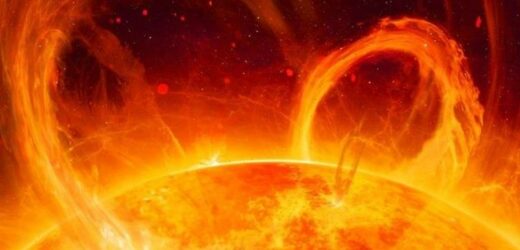The Space Race: Professor reveals carbon footprint of going to space
We use your sign-up to provide content in ways you’ve consented to and to improve our understanding of you. This may include adverts from us and 3rd parties based on our understanding. You can unsubscribe at any time. More info
The US Space Weather Prediction Center (SWPC) monitored a series of outbursts from the Sun which started on Monday. The Sun has been producing several coronal mass ejections (CMEs) throughout the week, with a “cannibal CME” striking the Earth on Thursday.
The SWPC, part of the National Oceanic and Atmospheric Administration (NOAA), has warned the “cannibal CME” could affect daily life.
In a statement, the SWPC said the geomagnetic storm could cause “voltage irregularities possible in the electric power grid, false alarms may be triggered on some protection devices” and “intermittent satellite navigation (GPS) problems”.
NOAA also noted spacecraft may be affected by phenomena like surface charging and orientation problems.
The agency added the storm might interfere with high-frequency radio signals at high latitudes, which could affect long-distance aeroplane flights.


NOAA’s satellites detected the CME which could affect the Earth on Thursday, with the storm reaching the Deep Space Climate Observatory (DSCOVR) spacecraft late on Wednesday.
DSCOVR is located about 1 million miles (1.5 million kilometres) away from Earth in the direction of the sun.
A forecast from SWPC also said: “G1 storm levels continue to be met and solar wind conditions remain elevated and enhanced, maintaining the potential for additional periods of G2-G3 level storms.”

Previously, the agency said a CME bound for Earth overtook and “swallowed” at least one other previous CME – a phenomenon known by some as a Cannibal CME.
SWPC’s website said: “It’s a CME that eats its own kind. On November 2, sunspot AR2981 hurled a fast CME towards Earth.
“As it approached our planet, it overtook at least one other CME and swallowed it.
“The mashed-up pair struck Earth on November 3 (8pm UTC).”

However, forecasters said Scottish people will be able to see the Northern Lights on Friday because of the CMEs.
Krista Hammond from the Met Office said: “As was predicted by the Met Office Space Weather Operations Centre, a coronal mass ejection impacted with the Earth yesterday.
“The resulting strong geomagnetic storm meant the Northern Lights were visible across large areas of the UK overnight last night.
“We’ve had reports that the aurora could even be seen in some central areas of the UK, which is possible when a storm of this magnitude impacts the Earth.
“Further geomagnetic storms are possible tonight and into the early hours of tomorrow morning, due to ongoing effects of the coronal mass ejection.”

Solar storms are ranked on a scale of “G1 Minor” to “G5 Extreme”.
At the far end of the scale, extreme storms have the potential to knock out satellites, disrupt communications and even cause some power grid systems to collapse.
At G3 level, satellites may experience increased drag from the atmosphere and there may be intermittent problems with satellite navigation and low-frequency radio navigation.
Source: Read Full Article
